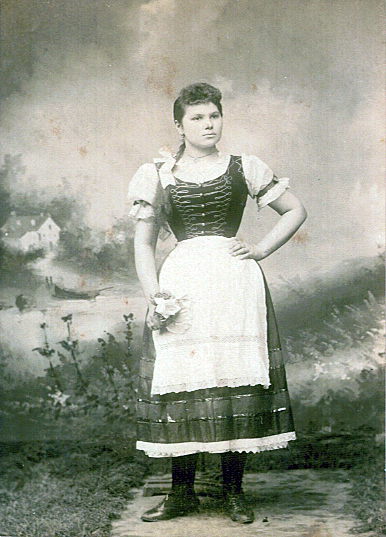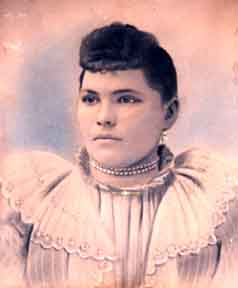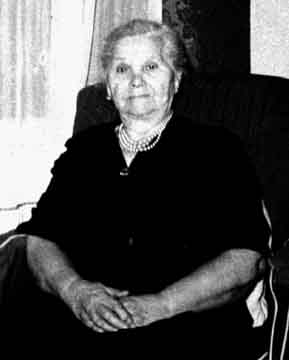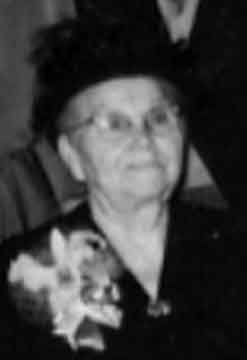THE HABURAY FAMILY

Julia at 16 years?
|
12/10/1874-6/4/1958  |
This portrait was probably done on the occasion of Albert and Julia's wedding, ca. 1894. She is ca. 20 years and he is ca. 30. The photo on the right is perhaps fifty years later in 1944 on the occasion of their fiftieth wedding anniversary. One wonders whether the pearls are the same. 5/1/00: The following is a review of all the notes I have in my Haburay and Mathea files and floating around in my memory. Among the many research angles to be followed up are checking further with Peggy Timothy and others to see whether some of Julia Haburay's effects wound up with them. |
about 1944  |
 |
We know very little about the Haburays. Family tradition says that Julia Bernadette Haburay was born in Slovakia or Bohemia in 1874 and came to the US from Bohemia to work for a rich family as a governess. She may have been an orphan. We don't have a date for her arrival in the US. There is a small town in the far-northeastern corner of Slovakia named Habura (in the Laborec Valley in the Carpathian Mountains on Highway 559) which may possibly be where the Haburays came from. It is my belief, based on childhood memories, that she was from "Ruthenia." Both ideas may be correct. There is even a question about how the name is spelled. My cousin insists that grandma used to say it was spelled like JANUARY and I think I remember my mother saying the same thing, though I must admit, HABURAY or even HABURAJ or HABURAI sounds more plausible and that is how the name was pronounced. Research must consider the variant spelling possibilities. |
She spoke Slavic and perhaps also Hungarian.
My father wrote of his meeting my mother at a National Guard dance which she attended with her cousin, Marie Sherer, Dan Sedlak's niece. Marie Sherer had a baby at the age of 45. I remember an aunt referring to other relatives but, again, I don't know on which side. (We have no information about anyone now on either side.)
Friends of the family were: Anthony Betchever, Andrew Kolarsky, Bittner. Downstairs tenant was Hopek. Steven Scavnicky (pronounced Shavnik) is said to have come to US with Julia Haburay.
In reviewing accumulated notes I also find mention that Julia Haburay had a (probable) cousin: Elizabeth Birkner.
Most of the family is buried in St. John's Cemetery in Brooklyn. Their children were: Emma, Ella, Marie, Ann, Julia, Albert, all deceased now. These names seem to approximately match the names of the earlier generations on the Mathea side. they could, of course, also match the names on the Haburay side but we don't know them.
Emma married Danial Sedlack, a furrier, had one child, Walter, (1919-1924) who died of diptheria at the age of 5 1/2. Ella married Cornelius Irving VanLoan and had 3 children. Marie married Edward Kerner and had 3 children. Ann did not marry until she was 44 and had no children. Julia married and had 7 children. Albert (1907-1930)died at the age of 23.
They lived for many years at 1397 Jefferson Avenue in the Bushwick section of Brooklyn. Earlier addresses are in the Greenpoint Section: 187 Bedford Ave (St Vincent DePaul) and 60 Diamond Street (St Anthony's/St Alphonsus). (A search of St Cecelia's records found no record.)
Here is HABURAY IMMIGRANTS TO AMERICA: the results of Mario Toglia's visits to the National Archives in Feb and July 2000. He found a record of a Julia Huburay (among others), but not our Julia. Could be a cousin. Perhaps other Haburay searchers will find something useful here.
HOME
7/18/00 - 1/5/09